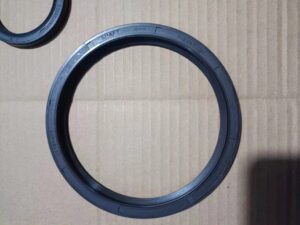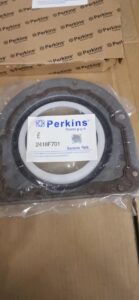Table of Contents
ToggleWhat Are Engine Oil Seals?
Engine oil seals are precision-engineered components crucial for maintaining engine integrity by retaining lubricating oil, preventing contamination, and ensuring smooth operation of rotating parts. These seals are strategically placed at key interfaces where moving shafts exit the engine, such as the crankshaft and camshafts. Their failure can lead to oil leaks, contamination, and even catastrophic engine damage. Below is a detailed exploration of their design, functions, types, and maintenance practices.


Definition and Core Purpose
Engine oil seals are specialized lip seals designed to:
- Retain Oil: Prevent lubricating oil from leaking out of the engine.
- Exclude Contaminants: Block dirt, dust, and debris from entering critical engine components.
- Maintain Pressure: Ensure stable oil pressure for hydraulic systems (e.g., lifters, turbochargers).
- Reduce Friction: Enable smooth rotation of shafts by maintaining an oil film.
These seals are typically constructed with a metal casing and an elastomer lip, forming both static (housing) and dynamic (shaft) seals.
Key Features of Engine Oil Seals
- Lip Design:
- A flexible rubber lip presses against the rotating shaft, supported by a garter spring to maintain consistent contact.
- Dual or triple lips may be used for enhanced sealing in high-stress areas.
- Outer Casing:
- Made of metal (steel or aluminum) or composites, press-fitted into the engine block or timing cover.
- PTFE coatings may be applied for reduced friction.
- Material Selection:
- Nitrile (NBR): Cost-effective, oil-resistant, ideal for standard engines (-40°C to 120°C).
- Viton® (FKM): High-temperature resistance (up to 200°C), used in turbocharged or high-performance engines.
- Silicone/HNBR: Flexible at extreme temperatures, suited for coolant-adjacent seals.
Types of Engine Oil Seals
| Type | Location | Function |
| Crankshaft Seals | Front and rear of the crankshaft | Prevent oil leaks at timing cover and transmission interface. |
| Camshaft Seals | Ends of camshafts | Retain oil in the cylinder head; integrated with timing covers. |
| Valve Stem Seals | Top of engine valves | Control oil flow to valve stems to prevent oil entering combustion chambers. |
| Oil Pump Seals | Oil pump housing | Ensure oil pressure stability; often O-rings or lip seals. |
| Turbocharger Seals | Turbo shaft interfaces | High-temperature seals to withstand oil and exhaust gases. |
Critical Locations in the Engine
- Front Crankshaft Seal:
- Positioned behind the timing belt/chain cover.
- Prevents oil from leaking near the crankshaft pulley or harmonic balancer.
- Rear Crankshaft Seal:
- Located between the engine and transmission.
- Critical for preventing oil from contaminating the clutch or torque converter.
- Camshaft Seals:
- Found at each end of camshafts in overhead-cam engines.
- Quantity varies: 2 seals for inline engines (SOHC), 4 for V6/V8 (DOHC).
- Valve Stem Seals:
- Small cup-shaped seals on valve stems.
- Regulate oil flow to prevent excess oil from burning in the combustion chamber.
Symptoms of Failing Engine Oil Seals
- Oil Leaks: Visible drips under the engine or oily residue on components.
- Low Oil Levels: Frequent need to refill oil between changes.
- Overheating: Reduced lubrication leading to increased friction.
- Contaminated Oil: Gritty texture or debris in oil due to seal breaches.
- Engine Noise: Knocking or ticking sounds from unlubricated parts.
Example: A leaking rear crankshaft seal can cause oil to pool beneath the transmission, leading to clutch slippage in manual vehicles.
Common Causes of Seal Failure
- Material Degradation:
- Heat, chemical exposure, or incompatible fluids causing hardening/cracking.
- Shaft Wear:
- Grooves or corrosion on the crankshaft/camshaft surface damaging the seal lip.
- Improper Installation:
- Misalignment or nicking during fitting.
- Age and Mileage:
- Natural wear over time, especially in high-mileage engines.
Maintenance Best Practices
- Regular Inspections:
- Check seals during oil changes, timing belt replacements, or engine servicing.
- Quality Replacement Parts:
- Use OEM or high-performance aftermarket seals (e.g., Viton® for turbo engines).
- Proper Installation:
- Clean shafts thoroughly; use alignment tools to avoid damage.
- Lubricate the seal lip before installation to prevent dry starts.
- Monitor Oil Health:
- Replace oil and filters regularly to minimize contamination.
Why Engine Oil Seals Are Critical
- Engine Longevity:
- Prevent premature wear of bearings, pistons, and cylinders.
- Performance:
- Maintain oil pressure for hydraulic systems (e.g., variable valve timing).
- Efficiency:
- Reduce oil consumption and emissions, improving fuel economy.
- Cost Savings:
- Avoid expensive repairs like engine rebuilds or turbocharger replacements.
Innovations in Seal Technology
- Advanced Materials:
- Hybrid seals combining EPDM and Viton® for multi-fluid resistance.
- Low-Friction Coatings:
- PTFE coatings reduce wear in high-speed applications.
- Smart Seals:
- Embedded sensors to monitor seal health and fluid integrity (emerging tech).
Replacement Guidelines
- Timing: Replace seals every 80,000–120,000 miles or during major engine work.
- Shaft Preparation: Polish or sleeve damaged shafts to restore a smooth surface.
- Tool Use: Employ seal drivers or sockets to ensure even installation.
Summary
Engine oil seals are indispensable for retaining lubricants, blocking contaminants, and ensuring engine efficiency. Key types include crankshaft, camshaft, and valve stem seals, crafted from materials like NBR or Viton® to endure harsh conditions. Symptoms of failure—such as oil leaks or unusual noises—demand immediate attention to prevent severe engine damage. Regular maintenance, proper installation, and using quality seals are vital for engine longevity and performance.



Leave A Comment